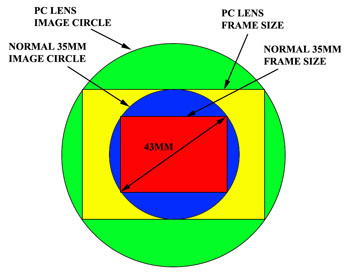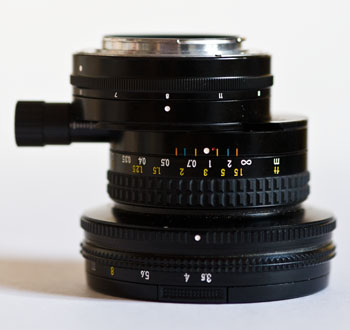Perspective control (PC) lenses are designed specifically to address the well-known "converging verticals" problem. They generally have focal lengths regarded as wide-angle ie 24mm - 35mm because they are intended for use when photographing large architectural subjects in restricted space - and hence relatively close up. They have two features that make them quite different from normal lenses.
The first of these is a large image circle. All lenses produce a circular image, but the quality of the image deteriorates towards the  outer edge of the circle. In the case of a 35mm or DSLR format lens, the diameter of the image circle's area of acceptable definition is sufficient to accommodate a 24mm x 36mm frame - ie a diagonal of about 43mm. The area of the image circle beyond this limit is likely to produce progressively lower image quality. In the case of a perspective control lens, the diameter of the area of acceptable definition is significantly larger.
outer edge of the circle. In the case of a 35mm or DSLR format lens, the diameter of the image circle's area of acceptable definition is sufficient to accommodate a 24mm x 36mm frame - ie a diagonal of about 43mm. The area of the image circle beyond this limit is likely to produce progressively lower image quality. In the case of a perspective control lens, the diameter of the area of acceptable definition is significantly larger.
 The second important feature of a PC lens is that the lens can be moved laterally relative to the axis of the lens mounting. This gives rise to the common name for a PC lens - shift lens. Since the lens can also be rotated on its mount, this lateral movement, which normally extends to 10mm - 15mm, can be made in any direction, giving an overall movement of 20mm - 30mm. The red area in the diagram, which is the area of an image projected onto the film or sensor and seen in the viewfinder, may therefore be moved within the green area, the area of acceptable definition - a distance almost equivalent of the width of the frame.
The second important feature of a PC lens is that the lens can be moved laterally relative to the axis of the lens mounting. This gives rise to the common name for a PC lens - shift lens. Since the lens can also be rotated on its mount, this lateral movement, which normally extends to 10mm - 15mm, can be made in any direction, giving an overall movement of 20mm - 30mm. The red area in the diagram, which is the area of an image projected onto the film or sensor and seen in the viewfinder, may therefore be moved within the green area, the area of acceptable definition - a distance almost equivalent of the width of the frame.
When using a PC lens, the camera is set up on a tripod in a horizontal position. In such a position, a normal lens would include too much foreground and exclude completely the top of a high building. However, the verticals in the image do not converge. By moving the PC lens off-axis, excessive areas of foreground are moved out of the bottom of the frame as the top of the building is lowered to a position within the frame. The verticals remain parallel and the building appears upright. It is important to work methodically and accurately to achieve good results.